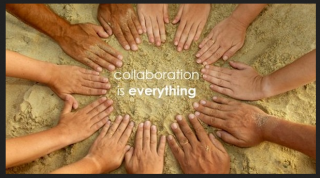The question of diversity, or lack of, within the creativity industries has been an issue for a long time, and over the last few years has steadily taken center stage in many discussions. As a response the idea of inclusivity has gained ground, and was part of the solutions posted in a previous blog. This blog seeks to look at a step by step approach to being inclusive both in an educational/training environment and within Creative companies.
Trust
Building trust amongst excluded, or under represented, communities is the biggest initial problem faced by anyone or any organisation seeking to be inclusive. Years of token gestures, institutionalised discrimination, or simply indifference has created a culture of mistrust amongst many communities. Examples range from expecting Black stories from Black writers, who may have wanted to write sci-fi or action thrillers, to never asking why no women were in heads of department positions or teams were 90% plus male to say nothing of why so many Oxbridge graduates dominated creative positions in the arts etc.
The cumulative effect of this has been to see many excluded individuals, or whole groups, feeling it s pointless to apply or train for a post as it will ultimately lead no-where. In this context it is not enough to merely create targeted schemes, quotas or adopted an inclusive policy. The aim has to be a strategy of long term development aimed at quality, and fair representation.
Step 1. Reaching Out
The first step is to go to the under represented communities where they are – not wait for them to apply to join you. All the groups which are currently excluded have organisations and/or networks which connect them together. Setting up short introductory courses to feed into your larger educational or training programme, or your company’s specific skills base. This may need to be done in a town, city or area away from your base but the cost of an overnight and travel expenses for one or two people to provide a weekend introductory course is a sign of real commitment. It goes a long way to building the all important trust needed for any strategy to work.
Step 2. Choosing the right Ambassadors
Sending a really senior person to be part of the initial conversation with groups, or to run an introductory course is a sign of commitment. So if this is the right person they should go. Why might they not be the right person? Trust is a difficult thing to build in the face of a history of discrimination. Therefore, it is critical in these first encounters that someone, in the team reaching out, fully understands the issues within the community you are seeking to include. It may be that they have direct experience themselves of discrimination but critically they must be aware of the specific issue relevant to the group/s being addressed, and be able to engage with questions raised in conversations.
Failure to understand or recognise issues, a defensive attitude, or simple ignorance will undermine any potential trust. It might appear obvious that the person who recruits staff, or runs a particular company, is the best person to send out as your ambassador but if they cannot reach out in a credible way then the strategy will fall at its first hurdle.
Step 3. Low Cost Access
We are not discussing here just physical access – as this should be taken as a given, and is legally required in most cases.. Access in its wider sense is about the cost of developing skills and issues of progression within a given creative environment.
To be cost effective initial steps have to be low cost. Hence the idea of very short courses which are open to relatively large groups or specifically targeted groups. By running them at weekends or as evening courses they become open to those who have existing jobs, only have child care for some out of work hours, and can only afford limited fees.
Where access involves specific skills in the use of particular sofware or technical equipment then access to these facilities needs to be on offer as part of the initial plan. This can be achieved by bulk purchase subscriptions on behalf of groups, sponsorship from equipment suppliers, grant aid (see below)or granting access to existing facilities. Many companies and educational institutions have equipment and facilities which are not in use at the weekend or for short periods. Setting up a network of these would be a great new step towards providing an inclusive environment.
Step 4. A ladder of Progression
To be attractive there needs to be a clear ladder of progression set out within the initial offer of the introductory sessions. This may be obvious within a big company, and for degree based education, etc. where routes to careers are part of the appeal. However, much of the creative industries is dominated by freelancers and the life of a freelancer has to be part of any offer being laid out to these excluded communities.
In the later context the importance of competitions, and the use if social media, etc. not only for connections, information, and in some cases training, but also as a means of distribution, and sales of work, need to be emphasised.
Step 5. Acts of Inclusion
The fear is always that you spend the money and time and its benefit goes to someone else or ends up producing no new entrants into your creative set up. The point is here we are a long way from developing our wider potential inclusive creative base and any shift in the inclusivity will sooner or later benefit everyone as the creative industries as a whole increase and the quality of work improves. Your contribution will pay off – you may just not see it at first.
In order to off set the costs involved in these endeavours then the use of grants from the lottery fund, arts councils and various charitable and not for profit organisations is an important part of the strategy, especially for small companies and freelancers.
These are the initial steps beyond these are the issues of recruitment, progression and visions of inclusion, but these are for another blog. Se Practical Steps https://blog.bcre8ive.net/visions-of-inclusion-more-practical-steps/


